Hotel Lobby Design Trends – 2024’s vision
In the world of hospitality, where first impressions are lasting impressions, the hotel lobby takes centre stage. It’s not just the gateway to a guest’s stay; it’s a carefully curated prelude to an unforgettable experience.
Join us on a journey to explore the captivating world of hotel lobby design, where every element, from furniture and art to colour and texture, plays a pivotal role in crafting that perfect first impression. In this realm, excellence is not an option—it’s the expectation.
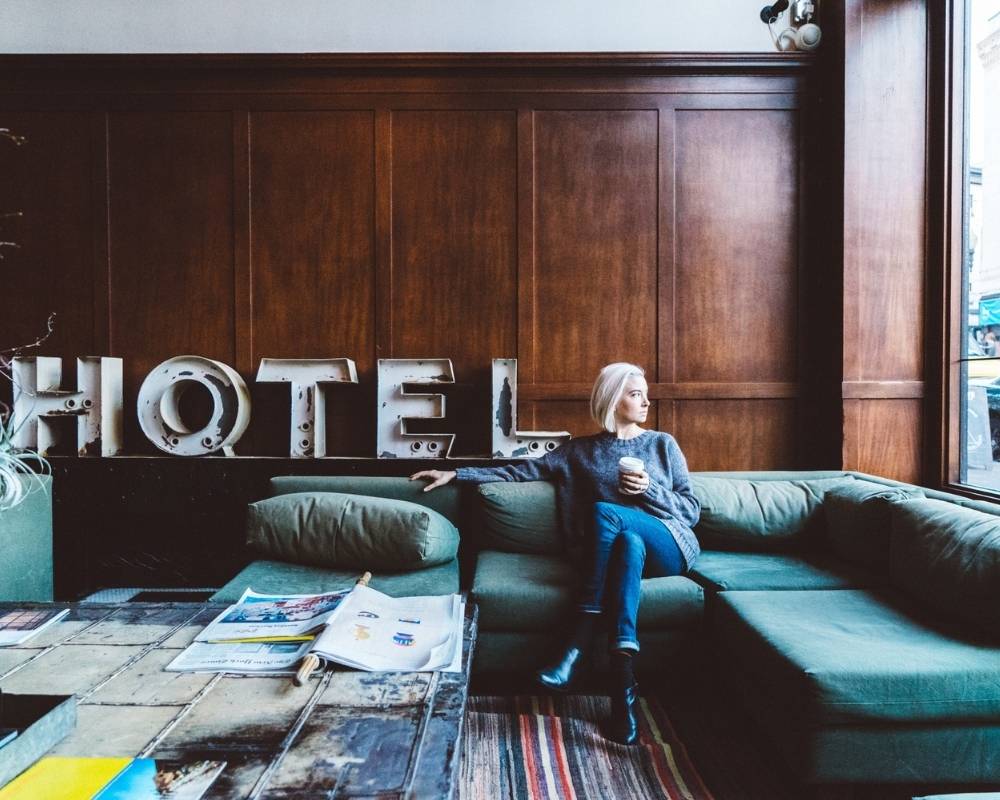
“Lifestyle Lobbies”
What exactly is a “lifestyle lobby”? Hotel lobbies are moving in a new direction, towards this idea of a lifestyle lobby. They are being designed to be more comfortable and welcoming– closer to your living room than to lobbies of years past, hence the name. They are designed for a lifestyle, rather than as an impressive pass-through space.
The Comforts of Home
Lobbies are now being redesigned, both in form and function, in order to make them appear more inviting. They are being designed to resemble modern living rooms, meant for interacting and socializing.
This is a departure from the previous hotel lobby design, where the primary function was to get the guests checked in and then move them out of the lobby and into their hotel room. This was important but now hotels are encouraging people to linger and interact with the space.
This is achieved by implementing the furniture and home accessories more similar to those you might find in someone’s home. Soft furnishings in approachable shapes, for example, are reminiscent of a person’s lounge space or living room at home. A gallery wall can resemble a similar feel as to one in your home. The emerging furniture style is tailored, but cozy offering guest comfortable lounge seating.
This also allows for a more communal, comfortable feel in the lobby, which is so important because it turns the lobby into a working space for business travellers to utilize. As opposed to generic artworks, the typical decor is now more personal or artistic– for example, ceramics and plants decorate these hotel spaces tastefully.
Biophilic Design
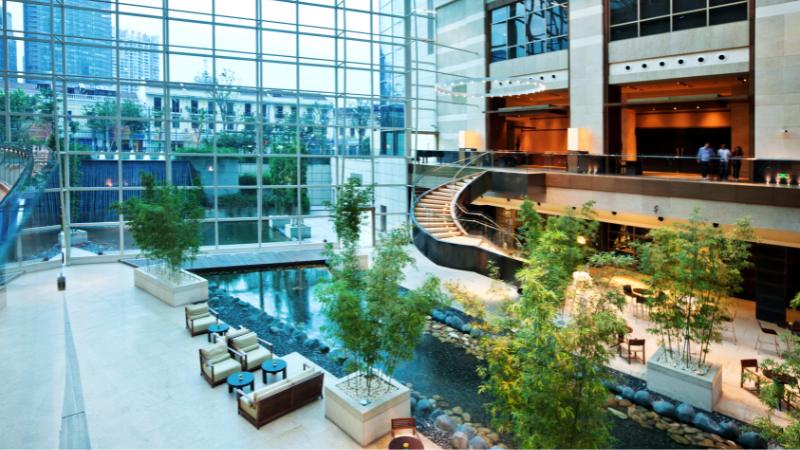
Biophilic design, with its central focus on fostering a connection with nature, is set to be a pivotal element in hotel design for the year 2024. This approach involves seamlessly incorporating the use of natural light, greenery, natural materials like wood and stone, and the incorporation of views of nature into interior spaces, enabling hotels to craft a tranquil and revitalizing ambiance that resonates with their hotel guests.
The concept behind biophilic design is based on the idea that humans have an innate connection to nature, and when this connection is reinforced in our surroundings, it can have numerous benefits for our physical and mental health.
Interactive Design

Lifestyle lobbies are not only cozy but interactive as well. This fosters more community in the lobby area and makes it more available as a common space, as opposed to a space to travel through on the way to your room. Often, a lobby is now set up with a common space, which may be an adjoining area or simply an additional space on an open floor plan. This area can be dedicated to the more interactive parts of the lobby and include more lounge furniture as being apart of the hotel design trends..
For example, video game stations and screens can be options explored to heighten engagement with guests and the hotel lobby. Another way to implement this interactive aspect is to make board games, such as Jenga or Scrabble, available in the lobby.
Certain areas or tables dedicated to interactive activities also help to solidify the lobby as a fun, modern common area which can include colourful lounge chairs.
Functionality Over Form
It is about the guest experience, so it is crucial that your hotel lobby be functional and designed accordingly– you want the communal space to be attractive, but it must be designed with its purpose in mind first. If a space is beautiful but is not functional, it will not feel welcoming.
Segmenting the Hotel Lobby Space
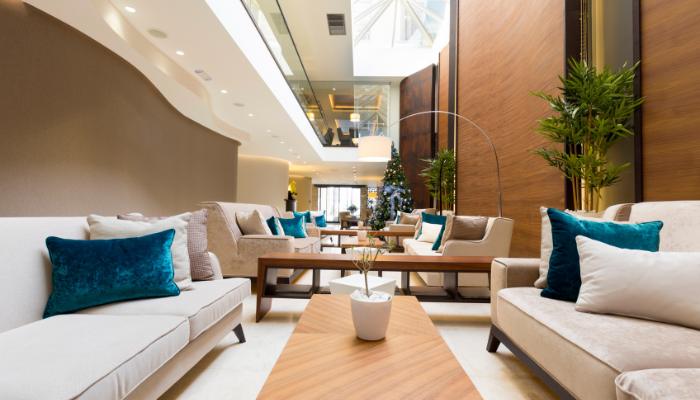
To successfully design a multi-functional lobby, many hotels utilize a structure that segments the space into different zones. Each zone is designed for a particular purpose. This does not mean that the zones are defined by walls, rather, the spaces can be defined by furniture or other creative options such as plant walls or screens. Having these segments in the lobby also increases the time spent in the space, as well as the quality of guest engagement with it.
For example, different zones could be designed for the check-in process, a waiting area, or social hangout space. Organize these spaces based on the natural flow through the lobby that you want to encourage. You would likely want your waiting zone to be close to the check-in area, and would want to decorate each area according to its purpose. A waiting area would benefit from a television screen or coffee table books so that hotel guests and business travelers can occupy themselves until it is time to move over to the check-in zone.
Technology in the Lobby
We are now seeing a change in tech for hotel lobbies. It is becoming increasingly important to implement smart technology into the check-in process and more. However, it is key that the technology does not overtake the experience and detract from the personal feel that is so important to convey to a guest.
Smart Technology
Smart technology is being put to use in the lobby during the checkout process as well as later on during guests’ stay. The use of mobile door keys is increasing, making it quicker and easier to check-in guests. It also serves as a convenience for guests throughout their time at the hotel– as long as guests have their phone, they run no risk of losing their hotel room key!
Many hotels are also implementing a messaging system, so that, rather than calling the front desk, guests can message hotel staff with their questions or needs. This is convenient for the guest as well as for the front desk staff. This keeps the phone lines free and saves the hotel time and money. The smart technology being brought into the hotel lobby experience increases interactions and efficiency.
Keeping the Human Element
While the implementation of new technologies is exciting and has a functional aspect to it, it is also important to keep the human element of the lobby experience as well. This is a careful balance that must be examined and taken into account. Technology offers many opportunities for innovation, but when it comes to hospitality, the human experience and connection are also key.
Many hotels are balancing the two by putting different spots at the forefront of the hotel lobby.
For example, if the hotel is using self-check-in screens, the design of the space moves away from the front desk as the focal point. Instead, stations that focus on social hospitality are placed as the central point. This could look like a complimentary champagne toast as guests enter the lobby for the arrival experience, or another such station.
Ultimately a good hotel lobby design focuses on how it makes people feel and what it encourages people to do while they’re there.
What Makes a Relaxing Atmosphere in a Hotel?
A relaxing atmosphere in a hotel will inspire guests but depends on several factors that contribute to the overall experience of the hotel guests. Here are some key elements that help create a calming and comfortable environment:
- Ambience: Soft lighting, natural light, soothing colour schemes, and pleasant background music can set the mood for relaxation. Natural elements such as plants or water features can also enhance the atmosphere.
- Cleanliness: A spotlessly clean and well-maintained hotel creates a sense of comfort and allows guests to unwind without any concerns about hygiene.
- Comfortable bedding: High-quality mattresses, soft linens, and a choice of pillows ensure a good night’s sleep, which is essential for relaxation.
- Quiet environment: Soundproofing measures like double-glazed windows or heavy curtains can help minimize noise from outside, while enforcing quiet hours can reduce disturbances from other guests.
- Personalization: Tailoring the guest experience to individual preferences, such as offering a variety of room types, aromatherapy options, and customizable temperature settings, can make guests feel more at ease.
- Amenities: Offering a variety of amenities, such as spa facilities, swimming pools, and fitness centers, can provide opportunities for guests to unwind and recharge.
- Friendly and attentive staff: Well-trained staff who are available to address guest needs promptly and courteously can greatly contribute to a relaxing atmosphere.
- Outdoor spaces: Beautifully landscaped gardens, terraces, or balconies can offer serene spots for guests to relax and enjoy nature.
- In-room entertainment: Providing a range of entertainment options like TV, streaming services, and Wi-Fi access allows guests to unwind in the comfort of their rooms.
- Complimentary refreshments: Offering complimentary tea, coffee, or snacks in the lobby or in-room can make guests feel more at home and encourage relaxation.
In summary, a relaxing hotel atmosphere is a combination of factors that focus on comfort, cleanliness, personalized service, and amenities that cater to guests’ needs and preferences.
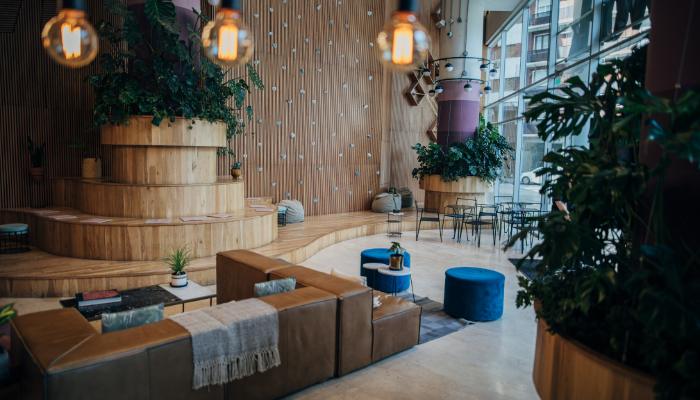
What are the top interior design ideas and hotel trends in a hotel lobby?
While specific design trends can vary over time, here are some popular interior design trends and hotel lobby design ideas:
- Open and Flexible Spaces: Hotel lobbies are increasingly being designed as multi-functional spaces that accommodate various activities. Flexible seating arrangements, movable furniture, and adaptable layouts allow for easy reconfiguration based on the guests’ needs and preferences.
- Biophilic Design: Incorporating elements of nature into the lobby design has gained significant popularity. The use of indoor plants, natural materials like wood paneling, living green walls, and ample natural light creates a welcoming and soothing atmosphere, connecting guests with nature.
- Statement Lighting: Eye-catching lighting fixtures serve as focal points in hotel lobbies. Large chandeliers, sculptural pendants, or unique light installations can add drama, elegance, and visual interest to the space.
- Warm and Inviting Color Palettes: Neutral and warm colour schemes are commonly used to create a welcoming and comfortable ambiance. Earthy tones, soft neutrals, muted hues and natural materials provide a soothing and timeless backdrop for the lobby design.
- Blend of Traditional and Contemporary Styles: Many hotel lobbies combine traditional and contemporary design elements to create a sophisticated and timeless aesthetic. Mixing classic architectural features with modern furnishings and decor creates a unique and memorable atmosphere.
- Technology Integration: Integrating advanced technology enhances the guest experience. This can include interactive digital displays, touchscreen directories, smart check-in systems, and personalized digital signage to provide convenience and engagement along with wifi access are all ways to integrate technology into the space.
- Artistic and Unique Accents: Hotel lobbies often feature curated artwork as well as local art, sculptures, or installations to add a touch of creativity and cultural richness. These art pieces can create conversation starters and contribute to the overall aesthetic appeal of the space.
- Cozy Lounge Areas: Creating comfortable and inviting lounge areas with plush seating, cozy nooks, coffee tables and intimate seating arrangements giving guests the opportunity to relax, socialize, and create a memorable experience.
Remember that design trends evolve, and it’s essential to consider the unique branding and target audience of the hotel when implementing any design choices. Many different types of hotels may have a specific brand image and the hotel lobby space may differ in design. You may want a luxury hotel lobby design, a contemporary hotel lobby design, or a modern hotel lobby design for example based on the type of hotel you are.
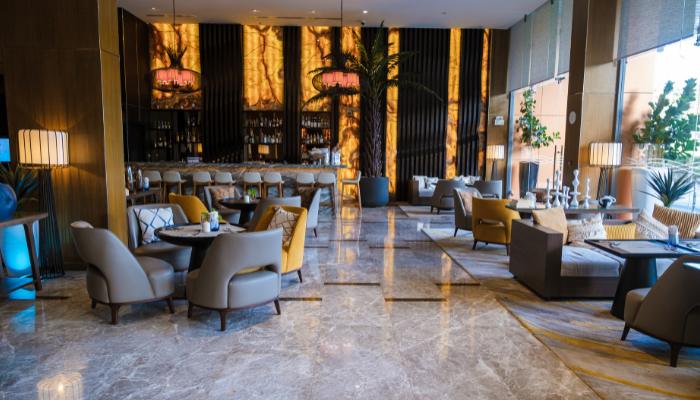
Calgary Interiors has been a leading provider of unique furniture for innovative spaces across western Canada for many years. Our extensive portfolio boasts numerous hotel lobby designs, restaurants, lounges, diners, hotels, medical clinics, reception areas, and collaborative office spaces. When it comes to furnishing your business with top-quality furniture crafted with meticulous attention to detail, and ensuring timely installation, you can always rely on our experienced team.
Get in touch with us today!

